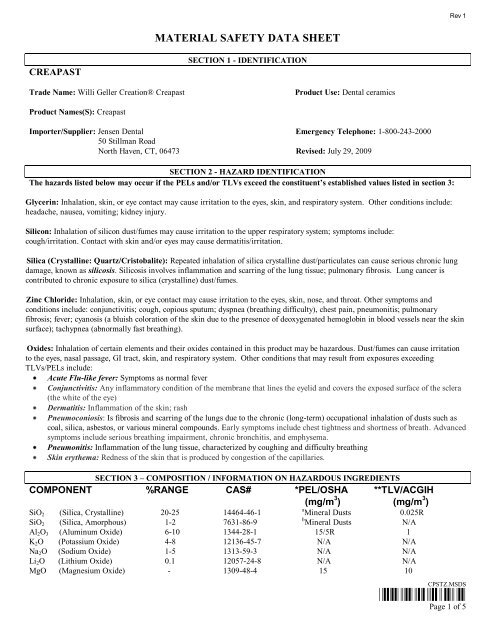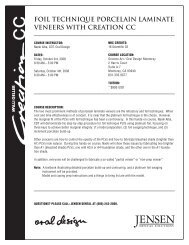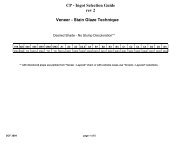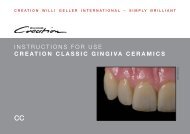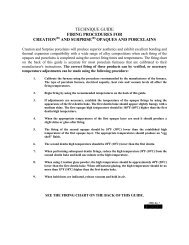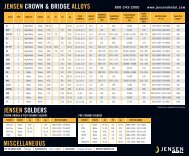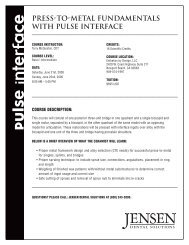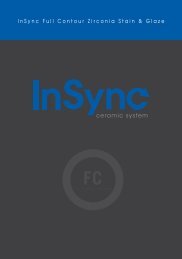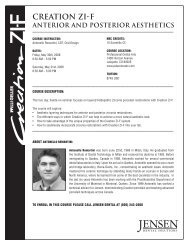Creapast MSDS - Jensen Dental
Creapast MSDS - Jensen Dental
Creapast MSDS - Jensen Dental
- No tags were found...
Create successful ePaper yourself
Turn your PDF publications into a flip-book with our unique Google optimized e-Paper software.
Rev 1MATERIAL SAFETY DATA SHEETCREAPASTTrade Name: Willi Geller Creation® <strong>Creapast</strong>SECTION 1 - IDENTIFICATIONProduct Use: <strong>Dental</strong> ceramicsProduct Names(S): <strong>Creapast</strong>Importer/Supplier: <strong>Jensen</strong> <strong>Dental</strong> Emergency Telephone: 1-800-243-200050 Stillman RoadNorth Haven, CT, 06473 Revised: July 29, 2009SECTION 2 - HAZARD IDENTIFICATIONThe hazards listed below may occur if the PELs and/or TLVs exceed the constituent’s established values listed in section 3:Glycerin: Inhalation, skin, or eye contact may cause irritation to the eyes, skin, and respiratory system. Other conditions include:headache, nausea, vomiting; kidney injury.Silicon: Inhalation of silicon dust/fumes may cause irritation to the upper respiratory system; symptoms include:cough/irritation. Contact with skin and/or eyes may cause dermatitis/irritation.Silica (Crystalline: Quartz/Cristobalite): Repeated inhalation of silica crystalline dust/particulates can cause serious chronic lungdamage, known as silicosis. Silicosis involves inflammation and scarring of the lung tissue; pulmonary fibrosis. Lung cancer iscontributed to chronic exposure to silica (crystalline) dust/fumes.Zinc Chloride: Inhalation, skin, or eye contact may cause irritation to the eyes, skin, nose, and throat. Other symptoms andconditions include: conjunctivitis; cough, copious sputum; dyspnea (breathing difficulty), chest pain, pneumonitis; pulmonaryfibrosis; fever; cyanosis (a bluish coloration of the skin due to the presence of deoxygenated hemoglobin in blood vessels near the skinsurface); tachypnea (abnormally fast breathing).Oxides: Inhalation of certain elements and their oxides contained in this product may be hazardous. Dust/fumes can cause irritationto the eyes, nasal passage, GI tract, skin, and respiratory system. Other conditions that may result from exposures exceedingTLVs/PELs include:Acute Flu-like fever: Symptoms as normal feverConjunctivitis: Any inflammatory condition of the membrane that lines the eyelid and covers the exposed surface of the sclera(the white of the eye)Dermatitis: Inflammation of the skin; rashPneumoconiosis: Is fibrosis and scarring of the lungs due to the chronic (long-term) occupational inhalation of dusts such ascoal, silica, asbestos, or various mineral compounds. Early symptoms include chest tightness and shortness of breath. Advancedsymptoms include serious breathing impairment, chronic bronchitis, and emphysema.Pneumonitis: Inflammation of the lung tissue, characterized by coughing and difficulty breathingSkin erythema: Redness of the skin that is produced by congestion of the capillaries.SECTION 3 – COMPOSITION / INFORMATION ON HAZARDOUS INGREDIENTSCOMPONENT %RANGE CAS# *PEL/OSHA **TLV/ACGIH(mg/m 3 ) (mg/m 3 )SiO 2 (Silica, Crystalline) 20-25 14464-46-1a Mineral Dusts 0.025RSiO 2 (Silica, Amorphous) 1-2 7631-86-9b Mineral DustsN/AAl 2 O 3 (Aluminum Oxide) 6-10 1344-28-1 15/5R 1K 2 O (Potassium Oxide) 4-8 12136-45-7 N/A N/ANa 2 O (Sodium Oxide) 1-5 1313-59-3 N/A N/ALi 2 O (Lithium Oxide) 0.1 12057-24-8 N/A N/AMgO (Magnesium Oxide) - 1309-48-4 15 10CPSTZ.<strong>MSDS</strong>*CPSTZ*Page 1 of 5
Rev 1CaO (Calcium Oxide)
Rev 1Flash Point: N/ASECTION 5 - FIRE FIGHTING MEASURESExplosive Limits: N/AExtinguishing Media: Use fire fighting measures that suit the environment: Foam, CO 2, extinguishing powder, or water jet.Fire & Explosion Hazards: Fire can cause release of nitrogen oxides (NOx) and ammonia (NH 3 ). Metal oxide fumes mayresult from intense heatingSpecial Fire Fighting Procedures: this material becomes airborne as a respirable particulate during a fire situation,pressure-demand self-contained breathing apparatus must be worn by firefighters or any other persons potentially exposedto the airborne dust.SECTION 6 - ACCIDENTAL RELEASE MEASURESSteps to Be Taken If Material Is Released or Spilled: Wear adequate respiratory protection for the severity of the spill.Cleanup should be conducted with a vacuum system utilizing a high efficiency particulate air (HEPA) filtration systemfollowed by wet cleaning methods. Special precautions must be taken when changing filters on HEPA vacuum cleanersused to clean up potentially toxic materials. Caution should be taken to minimize airborne generation of powder or dust.SECTION 7 - HANDLING AND STORAGEHandling: Wear an approved respirator when handling this product (see section 8).Storage: Store in original containerSECTION 8 - EXPOSURE CONTROLS / PERSONAL PROTECTIONVentilation and Engineering Controls: Whenever possible, the use of local exhaust ventilation or other engineeringcontrols is the preferred method of controlling exposure to airborne dust. Where utilized, pickups on flexible ventilationlines should be positioned as close to the source of airborne contamination as possible. Disruption of the airflow in the areaof a local exhaust inlet, such as by a cooling fan, should be avoided. Ventilation equipment should be checked regularly toensure it is functioning properly.Respiratory Protection: When potential exposures are above the occupational limits shown in Section 2, approvedrespirators must be used as specified by an Industrial Hygienist or other qualified professional. Respirator users must bemedically evaluated to determine if they are physically capable of wearing a respirator. Quantitative and/or qualitative fittesting and respirator training must be satisfactorily completed by all personnel prior to respirator use. Users of any stylerespirator must be clean- on those areas of the face where the respirator seal contacts the face. Exposure to unknownconcentrations of dust requires the wearing of a pressure-demand airline respirator or pressure-demand self-containedbreathing apparatus. Pressure-demand airline respirators are recommended when performing jobs with high potentialexposures such as changing filters in a baghouse air cleaning device.Housekeeping: Vacuum and wet cleaning methods are recommended for dust removal. Vacuum cleaners with highefficiency particulate air (HEPA) filters are the recommended type. The use of compressed air or brooms to remove dustsmust be avoided as such an activity can result in unnecessary short-term elevated exposures to airborne dusts.Maintenance: During repair or maintenance activities the potential exists for exposures to constituents in excess of theoccupational standards. Under these circumstances, protecting workers can require the use of specific work practices orprocedures involving the combined use of ventilation, wet and vacuum cleaning methods, respiratory protection,decontamination, special protective clothing i.e. lab coats, and when necessary, restricted work zones.Other Protective Equipment: NoneGloves: Rubber or latex gloves recommendedEye Protection: Wear safety glasses (goggles)Page 3 of 5
Rev 1Recommended Monitoring Procedures:Environmental Surveillance: Exposure to airborne materials should be determined by having air samples taken in theemployee breathing zone, work area, and department. The frequency and type of air sampling should be as specified by anIndustrial Hygienist or other qualified professional. Air sample results should be made available to employees.Medical Surveillance: Persons exposed to airborne concentrations of this material should be included in a periodic medicalsurveillance program. The program should include examination of the skin and respiratory system. Non-specific findingsof skin rash, skin granulomata, or respiratory signs or symptoms may indicate a reaction to this material.SECTION 9 - PHYSICAL AND CHEMICAL PROPERTIESColor: Various Melting Point ( C): N/A Density (g/cm 3 ): N/A Boiling Point: N/AEvaporation Rate: N/A Freezing Point: N/A Odor: none pH-value: N/APhysical State: Paste Radioactivity: N/A Solubility: Liquid components are water; soluble; solid and gas are notSublimes At: N/A Vapor Density (Air = 1): N/A Vapor Pressure (mmHg): N/A % Volatiles by Volume: noneSECTION 10 - STABILITY AND REACTIVITYGeneral Reactivity: This material is stable. Non-compatibility With Other Substances: Strong acids and oxidizing agentsHazardous Combustion Products: None under normal conditions of use.Hazardous Polymerization: Will not occur.SECTION 11- TOXICOLOGICAL INFORMATIONPRIMARY ROUTES OF EXPOSURE:Inhalation: Dust can be generated when dispensing the product for use, or when grinding the fired product. Lungirritation and/or pulmonary fibrosis are the principal conditions that can result from inhalation. Airborne exposure to Silicacrystalline, listed in Section 2, in excess of the occupational standards should be avoided.The potential for exposures may also occur during repair or maintenance activities on contaminated equipment such as:furnace rebuilding, maintenance or repair of air cleaning equipment, structural renovation, etc.Ingestion: There are no known cases of illness resulting from ingestion of this material. Ingestion can occur from dust orpowder contamination involved with hand to mouth activities such as eating, drinking, smoking, nail biting, etc. Theseproducts are not intended for internal consumption. As a standard hygiene practice, hands should be washed before eatingor smoking.Skin: Skin contact with this material may cause, in some sensitive individuals, dermatitis/irritation, due to the responsefrom silica. Skin abrasion may cause irritation. See Section 4 for additional information.Eyes: Injury can result from particulate irritation or mechanical injury to the eyes by dust or particulate. Exposure mayresult from direct contact with airborne particulate (dust or powder) or contact to the eye of contaminated hands or clothing.EFFECTS OF OVEREXPOSURE:The potential health effects listed below are confined to constituents which are in sufficient concentrationswithin the product to be significant.Acute (immediate or near-term health effects): In general, the airborne dust/fumes of silica listed in Section 2 can causeirritation to the skin, eyes, nose, throat, lungs, and mucous membranes.Chronic (long-term health effects): In general, the airborne dust/fumes of silica crystalline listed in Section 2 can causerespiratory disease with symptoms which include cough, chest pain, shortness of breath, weight loss, weakness, and fatigue.Exposure to airborne dust and fumes containing silica may cause long-term health effects including loss of lung function,fibrosis Cough, dyspnea (breathing difficulty), wheezing; decreased pulmonary function, progressive respiratory symptoms(silicosis); irritation eyes; [potential occupational carcinogen].Page 4 of 5
Rev 1CARCINOGENIC REFERENCES:NTP: Silica, crystalline is listed as a known to be human carcinogen.IARC: Silica, crystalline is listed as a Group 1 carcinogen: Carcinogenic to humansNIOSH: Silica, crystalline is listed as a potential carcinogen.Titanium Dioxide is listed as a potential carcinogenACGIH: Silica, crystalline is listed as an A2, suspected human carcinogenBarium Oxide is listed as an A4, not classifiable as a human carcinogen.Titanium Dioxide is listed as an A4, not classifiable as a human carcinogenMagnesium Oxide is listed as an A4, not classifiable as a human carcinogenAluminum Oxide is listed as an A4, not classifiable as a human carcinogenZirconium Oxide is listed as an A4, not classifiable as a human carcinogen.Medical Conditions Aggravated By Exposure: Persons with impaired pulmonary function, airway diseases, or conditions such asasthma, emphysema, chronic bronchitis, etc. may incur further impairment if dust or fume is inhaled.SECTION 12- ECOLOGICAL INFORMATIONLiquid components of this material are water soluble; solid and gas components are insoluble. There is no informationavailable on the ecological effects of the water soluble components of this material.SECTION 13- DISPOSAL CONSIDERATIONSWaste Management: Material and/or /packaging, containing powder, should be sealed inside a plastic bag when disposedof. Avoid washing down drains as material can plug drain. Comply with Federal, State, and local regulations.SECTION 14 – TRANSPORT INFORMATIONThere are no U.S. Department of Transportation hazardous material regulations that apply to the packaging and labeling ofthis product as shipped by <strong>Jensen</strong> Industries Inc.SECTION 15- REGULATORY INFORMATIONOSHA Hazard Communication Standard, 29 CFR 1910.1200: Components of these products are considered hazardousingredients.Wastewater: Wastewater regulations can vary considerably. Contact your local and state governments to determine theirrequirements.Other Regulations, Limitations and Prohibitive Regulations:German UVV: Protection against mineral dust which is harmful to health.California Proposition 65: Crystalline, silica is known to the state of California to cause cancer.SECTION 16 – OTHER INFORMATIONThis data is based on our present knowledge. However, that shall not constitute a guarantee for any specific productfeatures and shall not establish a legally valid contractual relationship. This <strong>MSDS</strong> has been revised following theguidelines outlined in CFR 1910-1200 “Material Safety Data Sheets.”Important: If you have any questions or require additional information regarding the materials described in thisMaterial Safety Data Sheet please contact <strong>Jensen</strong> <strong>Dental</strong> at 1-(800) 243-2000.Page 5 of 5


